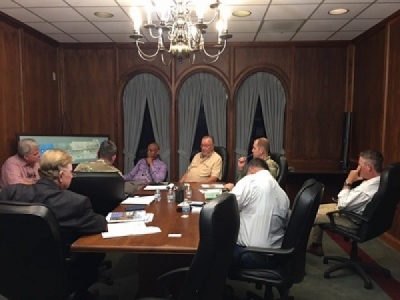
Posted on November 26, 2018
The news about Port Mansfield’s ship channel getting dredged by the U.S. Army Corps of Engineers has just gotten better, Willacy County Navigation District’s Executive Director Ron Mills reports.
Mills initially thought the much-needed dredging from the harbor to the sea buoy would be to a depth of 14-feet. However, he has now learned it will be to a depth of 17 or 18 feet.
This, Mills said, will be enough to allow offshore barges to navigate the ship channel, thus making Port Mansfield commercially viable once more.
“They (the Corps of Engineers) told us in the agreement that we are going to get a 14-foot channel. But they have written into the contract that they want to take out another four foot of material so they don’t have to come back and dredge for several years. So, the 14-foot channel could be as much as 18 feet deep,” Mills said, in a recent verbal report to the navigation district’s board of directors.
“I cannot solicit offshore business through a 14-foot channel. They cannot fit, offshore barges won’t make it. But, with these new numbers it looks like we may be able to do the offshore barge concept, coming through the channel to help us and (the Port of) Harlingen receive cargos and make that cut more viable.”
As first reported in the Rio Grande Guardian, Mills was shocked to learn last July that the Corps of Engineers had been allocated tens of millions of dollars to dredge Port Mansfield’s ship channel. For years, the Corps had told him they did not have sufficient funds.
Things were made worse by 2017’s Hurricane Harvey, which washed up a lot of sand and silt, leaving the channel virtually impassable. As a result, commercial activity at the port ground to a halt.
However, Mills and The Shepherd Group did not take “no” for an answer. The Shepherd Group, headed by veteran public policy advocate Ron Whitlock, was hired by the navigation district as consultants. Whitlock visited Washington, D.C., in June to press members of the Texas congressional delegation to provide the Corps of Engineers a bigger budget for dredging. Mills and Whitlock also met with Col. Lars N. Zetterstrom, who commands the Corps of Engineers’ Galveston district. The result? Tens of millions of dollars awarded to the Port Mansfield project.
In his report to the board of directors, Mills spoke about the timeline for the Corps of Engineers to do its work.
“In December or January, a pilot channel will be dug from the harbor out to intracoastal waterway. That pilot channel is actually probably going to be deeper than our dredging job was in 2015. I suspect the pilot channel will be as deep as 12 to 14 feet. That is going to be a short-term resolution from the harbor to the intracoastal. That material will be dumped on Bird Island because it will be in the off-season,” Mills explained.
“Bird Island starts roughly the last week of March and runs until the last week of August. But, they have already negotiated an agreement with U.S. Fish & Wildlife. They have already been given permission to proceed in July with the construction of Bird Island.
“What do I mean by construction? They are actually going to build a Rip Rap island, eight or ten feet high, with a weir to drain off any excess materials. That will start in July and be finished no later than mid-August. So, the island area will be there.”
Mills said the material dredged will be moved to two places.
“The channel that goes from the sea buoy all the way to the harbor, that channel is going to be split, basically, in half. (Material dredged) from the halfway point to the jetties will be put on the beach of the national seashore and the (dredged material) from the halfway point to the seashore is going to be put on Bird Island,” Mills said.
Mills said the major dredging operation will probably begin next September.
Source: Rio Grande





